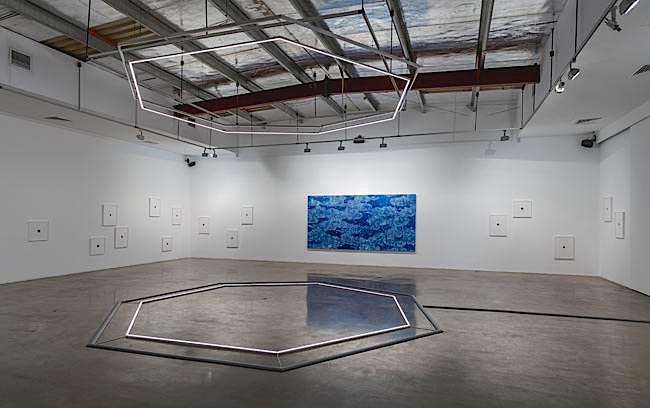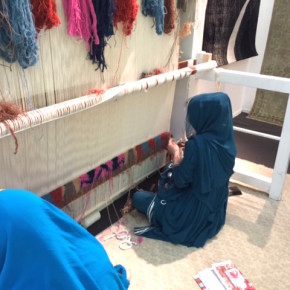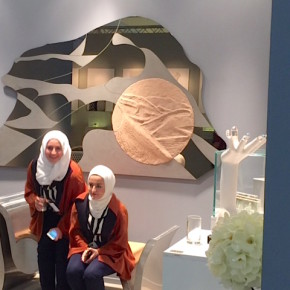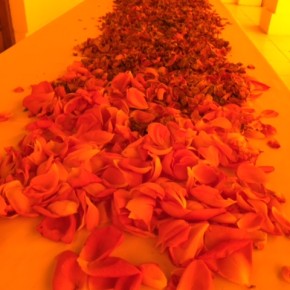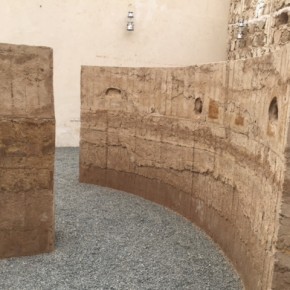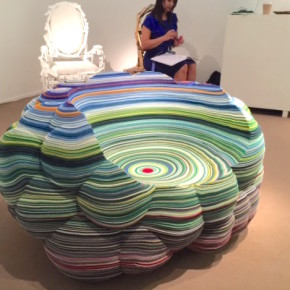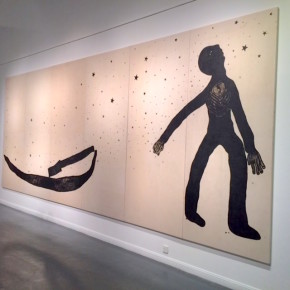A Visit to Art Dubai/ Design Days Dubai/Sharjah Biennial
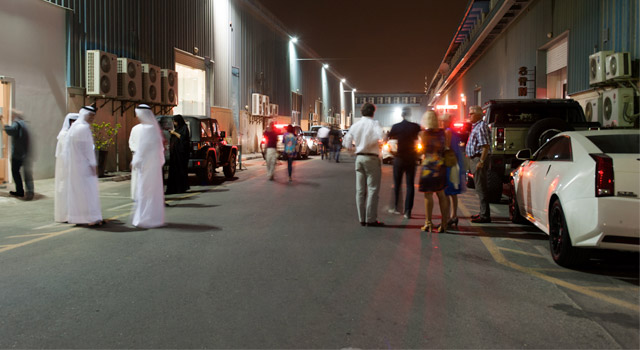
Alserkal Avenue: the gallery scene here is clustered with facades of understated corrugated metal, Photograph by Vikki Tobak, 2015
In a growing effort to assert its status as one of the world’s fastest growing global art markets, Dubai Art Week kicked off with the ninth edition of Art Dubai at the über luxurious Madinat Jumeirah Hotel. If you like art and chic indoor ski slopes, Dubai is the place to be. Art week, is a key annual highlight of the UAE United Arab Emirates increasingly powerful art scene. Art Dubai was just one stop as a range of globally represented galleries, collectors and art lovers maneuvered across the region to Design Days Dubai. Also coinciding with both Art Dubai and Design Days Dubai were a series of gallery openings centered around Alserkal Avenue, a burgeoning gallery district located in the industrial neighborhood of Al Quoz. In the nearby emirate of Sharjah, the 12th iteration of The Sharjah Biennial: The past, the present, the possible (SB12, 5th March – 5th June, 2015) focuses on installations and projects with ambitious curatorial direction from Eungie Joo, formerly of the New Museum, New York.
Art Dubai
This year Art Dubai (18th – 21st March, 2015), was the largest and most international edition to date, welcoming 92 participating galleries from 40 countries and featured the work of more than 500 artists across its three gallery programs: Contemporary, Modern and Marker. Attendees reported an overall maturation to the fair, most noticeable as galleries responded to an evolving regional market and an increasingly sophisticated collector base.
Some notable gallery absentees who have previously participated included Marian Goodman and Gladstone Gallery. This was most likely due to the simultaneous scheduling of Art Basel Hong Kong and a denser worldwide fair schedule. Meanwhile new galleries to the fair included LA’s Honor Fraser, showing a solo booth of artwork by artist KAWS.
Going on an art-focused trip to the UAE can put one slightly off-balance. Dubai is a city that makes you question everything you know about so many things including urban planning, spatial authenticity, the art market and more. There is so much newness to it all, including record-setting skyscrapers It’s a city of luxury brands and nonstop construction; A city of complexity at a crossroads, in an age of globalization. It is developmentally focused on progress, modernity and committed to fostering the arts both from a global and regional perspective. The winner of the seventh Abraaj Group Art Prize, Yto Barrada, exhibited her specially commissioned sculptural work and film, Faux Depart, alongside works by shortlisted artists Mounira Al Solh, Setareh Shahbazi and Sarnath Bannerjee.
“I do a lot of fairs and visit a lot of fairs, and I thought Art Dubai was exactly the right size,” says LA-based dealer Charlie James. “It felt like the audience was thoughtfully assembled and very engaged in both the fair and the Dubai Art Week overall, and I appreciated that much of the work on display was content-based and political, quite uncommon on the international fair circuit I think. I had a great time, made new friends, and would be happy to return for future editions.”
A growing gallery scene in Al Quoz
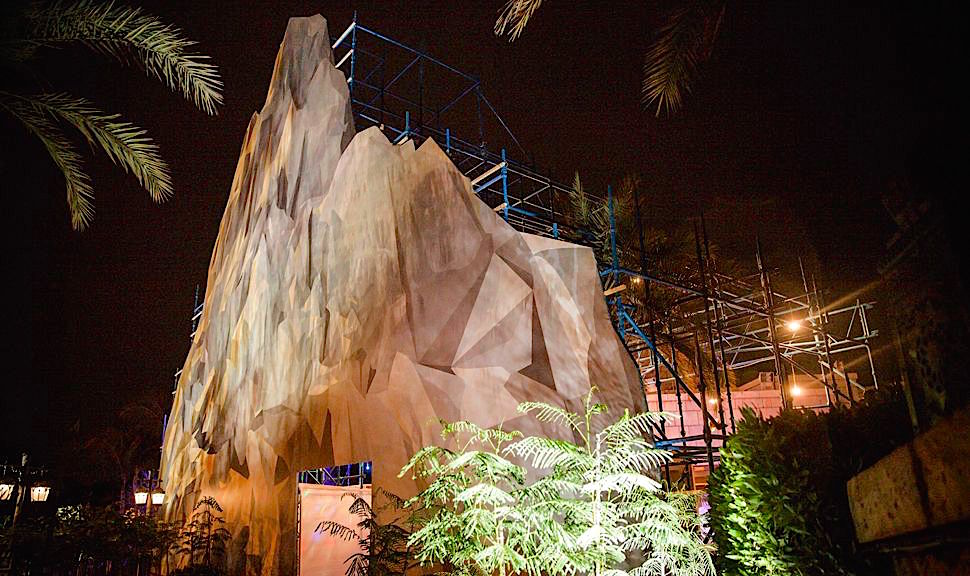
Yazan Khalili and Arnar Ásgeirsson’s “The Island’ commissioned by Absolut Art Bar at Art Dubai 2015. Photograph by Vikki Tobak, 2015
In stark contrast to Dubai’s glittering skyscrapers and shiny facades, the Al Quoz neighborhood is being touted as “an industrial, dusty, gritty, organic area — a mix of old and new, where car warehouses live next to contemporary art galleries and bakeries border skateparks.” Galleries including The Third Line and Ayyam have found a home on and around Alserkal Avenue, an arts complex where galleries are clustered inside corrugated metal facades. Lawrie Shabibi, Carbon 12, and Gallery Isabelle van den Eynde all have their spaces here, The Third Line is planning to relocate to the area in the fall, and New York’s Leila Heller will open an outpost later in 2015. The zone feels young and has good energy, serving as a home for Dubai’s growing collector base.
One standout special project was Yazan Khalili’s Absolut Art Bar just outside of the Art Dubai fair, within the larger artifice of the Madinat Jumeirah hotel. Khalili, a Palestinian artist currently based in Amsterdam, works to incorporate fictional histories as a means of cultural commentary. For this project, he collaborated with Icelander Arnar Ásgeirsson to construct a massive façade of a “mountain,” supported by a jumble of blue scaffolding. Upon entering, the visitor is faced with navigating the real vs. fictional, a not too uncommon feeling in Dubai overall. These special commissions were a standout during the fair but overall Dubai is sorely lacking in public art.
Design Days Dubai

“Posa’ by Massimo Faion presented by Carwan Gallery. AN installation of four collectible falcon perches, complete with a live falcon. Photograph by Vikki Tobak, 2015
Occurring at the same time as Art Dubai was Design Days Dubai held across town at the base of the Burj Khalifa tower — the world’s tallest building. Now in its fourth year, Art Dubai’s design-focused sister fair was smart and concise, largely due to director Cyril Zammit’s close editing of and quality initiatives that focused on forward thinking materials, regional craft and design. All in all it was a decidedly Middle East take on the global design market. Participants of note at Design Days Dubai include world-renowned architect ZahaHadid and FBMI (Fatema Bint Mohammed Bin Zayed Initiative) who provide work for Afghan women in the carpet production process.
Sharjah Biennale
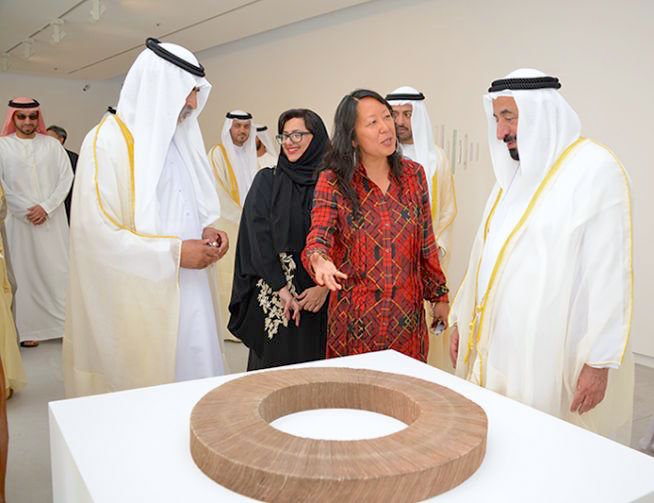
Sharjah Biennial opening, left to right, HH Sheikh Nahyan bin Mubarak, HE Sheikha Hoor Al-Qasimi, SB12 Curator Eungie Joo, HH Sheikh Khalid Al Qasimi and HH Sheikh Sultan Al Qasimi. Photo by Alfredo Rubio, 2015
A short 30-minute drive from Dubai and you will find yourself in the neighboring emirate of Sharjah. Settling into the maze of walled alleyways, the 12th edition of the Sharjah Biennial unfolds, an ambitious feat of site-specific installations curated this year by Eungie Joo and Sheikha Hoor Al Qasimi, the head of the Sharjah Foundation and trustee of MoMa Ps1.
Titled “The past, the present, the possible (SB12)”, the biennial brought together 51 artists and collectives, 36 who were commissioned with investigative research-based trips and residencies by SB12 to create site-specific works. The artists of SB12 focus on a broad spectrum of cultural themes. One standout example is Danh Vo’s grand-size copper replica of the Statue of Liberty (just the armpit that is), reassembled with the title of “Come to where the flavours are” (2015) in a historic courtyard.
The conversation continues with Rirkrit Tiravanija, who recreated a rosewater distillery inspired by the 14th century model found in Sharjah’s Museum of Islāmic Civilization. Also found here is Lebanese artist Rayyane Tabet’s “Steel Rings” (2013), installed beneath classical Arabesque arches. The sculptural installation serves as a reminder of the Trans-Arabian Pipe Line Company, built in 1948 to transport oil from Saudi Arabia to Lebanon and across Jordan and Syria.The pipeline is no longer in operation but the company continued operating with no oil being transported until the end of 2002, when Aramco fully closed the Tapline subsidiary. Notably lacking in SB12 are a larger quantity of artworks relevant to UAE issues such as the value of labor, women’s rights, or the stronghold of religion. This leaves room for expansion and further exploration for Sharjah Biennial 13.

Rayyane Tabet, Steel Rings, 2013 at Sharjah Biennial
Rolled engraved steel. 80 x 10 x 0.6 cm each.
Image courtesy of Sharjah Art Foundation. Photo by Deema Shahin, 2015
- Danh Vo, Come to where the flavours are, 2015, Copper, gold leaf on cardboard. Sharjah Biennial 12, Photograph by Vikki Tobak
- “Weaving enterprise and compassion” FBMI (Fatema Bint Mohammed Bin Zayed Initiative) provides work for Afhan women in the carpet production process, Photograph Vikki Tobak
- View from Design Days Dubai, Photograph by Vikki Tobak, 2015
- Julie Mehretu at Sharjah Biennial, Photograph by Vikki Tobak, 2015
- Fahrelnissa Zeid, Someone From The Past. Oil on canvas 1980 at Sharjah Biennial, Photograph Vikki Tobak, 2015
- Rirkrit Tiravanija, untitled (Eau de Rose of Damascus), 2015 at Sharjah Biennial, Photograph Vikki Tobak, 2015
- Damián Ortega, Talking Wall, 2015. Wooden cast, clay, sand, gravel, hay, rocks, Styrofoam ear pieces and flexible PVC pipes, Photograph Vikki Tobak, 2015
- Design Days Dubai, Booth installation view, Photograph Vikki Tobak, 2015
- Sadik Kwaish Alfraji at Ayyam Gallery, Photograph Vikki Tobak, 2015
This is the first contribution from Vikki Tobak, who is based in Washington DC, for Eyes Towards the Dove.
More soon.
xo

